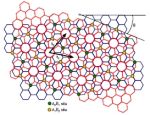EPJ B Highlight - Quasi-particle swap between graphene layers
- Details
- Published on 21 January 2014

Equations used to describe parallel worlds in particle physics can help study the behaviour of particles in parallel graphene layers
Belgian scientists have used a particle physics theory to describe the behaviour of particle-like entities, referred to as excitons, in two layers of graphene, a one-carbon-atom-thick honeycomb crystal. In a paper recently published in EPJ B, Michael Sarrazin from the University of Namur, and Fabrice Petit from the Belgian Ceramic Research Centre in Mons, studied the behaviour of excitons in a bilayer of graphene through an analogy with excitons evolving in two abstract parallel worlds, described with equations typically used in high-energy particle physics.
The authors used the equations reflecting a theoretical world consisting of a bi-dimensional space sheet—a so-called brane—embedded in a space with three dimensions. Specifically, the authors described the quantum behaviour of excitons in a universe made of two such brane worlds. They then made an analogy with a bilayer of graphene sheets, in which quantum particles live in a separate space-time.
They showed that this approach is adapted to study theoretically and experimentally how excitons behave when they are confined within the plane of the graphene sheet.
Sarrazin and his colleague have also theoretically shown the existence of a swapping effect of excitons between graphene layers under specific electromagnetic conditions. This swapping effect may occur as a solid-state equivalent of known particle swapping predicted in brane theory.
To verify their predictions, the authors suggest the design for an experimental device relying on a magnetically tunable optical filter. It uses magnets whose magnetic fields can be controlled with a separate external magnetic field. The excitons are first produced by shining an incident light onto the first graphene layer. The device then works by recording photons in front of the second graphene layer, which provide a clue of the decay of the exciton after it has swapped onto the second layer from the first.
M. Sarrazin and F. Petit (2014), Exciton swapping in a twisted graphene bilayer as a solid-state realization of a two-brane model, European Physical Journal B, DOI 10.1140/epjb/e2013-40492-5




